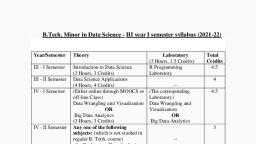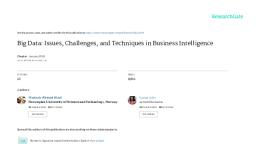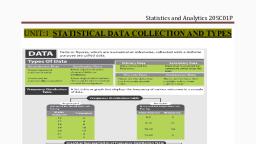Page 1 :
MODULE 3, , BUSINESS DATA ANALYSIS
Page 2 :
INTRODUCTION, Business data analysis includes the activities to help managers make strategic, decisions, achieve major goals and solve complex problems, by collecting, analyzing and, reporting the most useful information relevant to managers' needs. Information could be, about the causes of the current situation, the most likely trends to occur, and what should be, done as a result., Features of New Generation Computers, Ist Generation: (1940 -1956), Vacuum tubes were used in circuits, These computers are very large in size, They require a large amount of electricity, They produce more heat, They are less revival, Ex: ENIAC, UNIVAC, IInd Generation: (1940 -1956), Vacuum tubes were replaced by transistors in circuits, Small size as compared to Ist Generation Computers, Less amount of heat Generation, Less electricity consumption, Ex.: IBM 350, IIIrd Generation: (1963 -1972), Transistors were replaced by I.C. in circuits(I.C. – Integrated circuits), Small size as compared to IInd Generation computer, Less amount of heat as compared to IInd Generation computer, Less electricity consumption, Faster and more accurate than IInd Generation computer, Ex.: IBM 360/370, IVth Generation: (1963 -1972), LSI and LSVI technologies are used, LSI- Large scale integration, LSVI – Very large integration, Microprocessors are developed, Apple-II, STAR 1000, Vth Generation: (Present & Beyond), It is based on the technique of Artificial Intelligence (AI), Computer can understand spoken words, Scientist are constantly working to increase the processing powof computers, They are trying to create a computer with real IQ with the help of advanced programming, and technologies, Ex.: IBM Watson, Concept of data analysis, Data is the main ingredient for any BI, data science and business analysis initiative. In fact, it, can be reviewed as the raw material for what these popular decision technologies produce –, information, insight and knowledge. Data can be a small or it can be very large, it can
Page 3 :
structured or it can be unstructured. It can come in smaller batches continuously or it can, pour in all at once as a large batch., Business Data Analysis, Business Data Analysis is the process by which businesses use statistical methods and, technologies for analyzinghistorical data in order to gain new insight and improve strategic, decision-making. In other words, a data management solution and business intelligence, subset, refers to the use of methodologies such as data mining, predictive analytics, and, statistical analysis in order to analyze and transform data into useful information, identify and, anticipate trends and outcomes, and ultimately make smarter, data-driven business decisions., The essentials of business data analysis are typically categorized as either descriptive, analytics, which analyzes historical data to determine how a unit may respond to a set of, variables; predictive analytics, which looks at historical data to determine the likelihood of, particular future outcomes; or prescriptive analytics, the combination of the descriptive, analytics process, which provides insight on what happened, and predictive analytics process,, which provides insight on what might happen, providing a process by which users can, anticipate what will happen, when it will happen, and why it will happen., Data Analyst, A data analyst is someone who uses technical skills to analyze data and report insights. Data, Analysts are professionals who translate numbers, statistics, and figures, into understandable, values. A Data Analyst collects, stores, and interprets data to transform it into valuable, business insights that can be used to improve business operations and foster data-driven, decision making. Since this job role involves parsing through data, analyzing it, and, interpreting it, it is primarily analytical., An analyst is a person who analyzes and is skilled in analysis. Business Analysts (BA) are, required to find, analyze and report business data to support business optimization., Importance of data quality, Impoved data quality leads to better decision – making across an organization. Data quality is, important because without high-quality data, you cannot understand or stay in contact with, your customers. In this data-driven age, it is easier than ever before to find out key, information about current and potential customers. This information can enable you to market, more effectively, and encourage a loyalty that can last for decades. Rest assured that if you, are not convinced of the importance of data quality, your competitors are, and they will not, hesitate to strive for the best data to improve their own competitive advantage. Maintaining, data quality is a difficult but necessary task. In order to achieve consistent and reliable, customer data, businesses must constantly manage data quality so that they build trust and, enable quicker, more knowledgeable decisions., General Steps for Analysis with Missing Data, 1. Identify patterns/reasons for missing and recode correctly, Attrition due to social/natural processes, Example: School graduation, dropout, death ;, Skip pattern in survey, Example: Certain questions only asked to respondents who, indicate they are married ; Intentional missing as part of data collection process;, Random data collection issues; Respondent refusal/Non-response, 2. Understand distribution of missing data, Consider the probability of missingness; Are certain groups more likely to have, missing values?; Example: Respondents in service occupations less likely to report income
Page 4 :
Are certain responses more likely to be missing?; Example: Respondents with high income, less likely to report income; Certain analysis methods assume a certain probability, distribution, 3. Decide on best method of analysis, Use what you know about; Why data is missing; Distribution of missing data; Decide on the, best analysis strategy to yield the least biased estimates; Deletion Methods; List wise, deletion, pair wise deletion; Single Imputation Methods; Mean/mode substitution, dummy, variable method, single regression; Model-Based Methods; Maximum Likelihood, Multiple, imputation, Social Networking Analysis, Social network analysis is an ideal tool for gaining insights into our increasingly connected, world. Social media has the potential to improve social priorities such as government, transparency, disaster response, education, and citizen science. However, it also has been, increasingly used for nefarious purposes in recent years through misinformation campaigns,, profiling, election meddling, and anti-vaccine propaganda. Researchers in social network, analysis have provided a set of concepts and metrics to systematically study these dynamic, processes. Innovators in information visualization have also contributed to helping users to, discover patterns, trends, clusters, gaps, and outliers, even in complex social networks. Each, day solutions for better network insights are being found that bring competitive advantages to, business product developers, opportunities for government agency staffers, and new, possibilities for nongovernmental social entrepreneurs., Social network analysis uses mathematical tools to systematically understand networks,, which are made up of vertices (e.g., people) that are connected to one another via edges (e.g.,, friendship ties). Network metrics help identify who is most important or central in a network,, subgroups (i.e., network clusters) of tightly connected people, and the overall network, structure (e.g., the density of a network). Social scientists have developed social network, analysis and visualization techniques for decades. Network data is represented as an edge list, or matrix. Directed edges have a clear origin and destination, while undirected edges do not., Weighted networks include a value associated with the edge. The scope of a network, determines if it is an ego network, partial network, or full network. Multimodal networks, include vertices of different types, while multiplex networks include edges of different types., Affiliation networks connect people based on shared affiliations (e.g. club), Big Data Analysis, Big Data, which means many things to many people, is not a new technological fad. It has, become a business priority that has the potential to profoundly to change the competitive, landscape in today’s globally integrated economy. Traditionally, the term Big Data has been, used to describe the massive volumes of data analyzed by huge organization like Google or, research science projects at NASA. The point is more about finding new value within and, outside conventional data sources. Pushing the boundaries of analysis uncovers new insights, and opportunities and “big” depends on where you start and how you proceed. Big data has, become a popular term to describe the exponential growth, availability and use of information, both structured and unstructured. Use of the term Big Data is usually associated with, technologies., The role of data scientist is becoming more pivotal to even traditional organizations who, didn’t previously invest much of their budgets in technology positions. Big data is
Page 5 :
changing the way old-school organizations conduct business and manage marketing, and the, data scientist is at the centre of that transformation., Role of Data Scientist in Business & Society, Data scientist help companies interpret and manage data and solve complex problems using, expertise in a variety of data niches. They generally have a foundation in computer science,, modelling, statistics, analytics and math-coupled with strong business sense It’s this merging, of estoric intelligence and practical knowledge that makes the data scientist so valuable to a, company. The growing importance of data analytics in business is leading to the appointment, of senior data scientists to provide company-wide insights., Role of Artificial Intelligence and Intelligent Agents in ebusiness, In recent years the World Wide Web has become largest market place due to its, exponential growth enabled extensive progress in new information society functions such as, electronic commerce. Electronic commerce, known as e-commerce, is a type of industry, where buying and selling of product or service over electronic systems such as the Internet, and other computer networks. Simply ecommerce is buying and selling over the internet, medium. Electronic commerce involves business to business (B2B), business to customer, (B2C) and customer to customer (C2C) transactions. It covers a wide variety of issues, including security, trust, reputation, law, payment mechanisms, advertising, ontologies,, electronic product catalogs, intermediaries, multimedia shopping experiences, and back office, management. Agent technologies can be applied to any of these areas in e- commerce. In the, system, either on its own initiative or under the direction of a user. Each intelligent agent can, be readily replicated and then distributed as needed. This agent-based approach to, information management is both scalable and cost effective., Ethical and Legal considerations in Business Analytics, The power of Data can be used for nefarious purposes and this is raising ethical, concerns in data analysis businesses. This fear has led to an active discussion on ethics in, data analytics. With the well-known case of Cambridge Analytical scandal and the roll-out of, GDPR, data analytics ethics is too often an afterthought. In the modern digital society, where, social data seems to spread at the sped of light, we are seeing controversial and sometimes, downright illegal use of sensitive data. Some individuals are taking a stand and even, resigning their jobs to avoid perpetuating misleading facts.















































